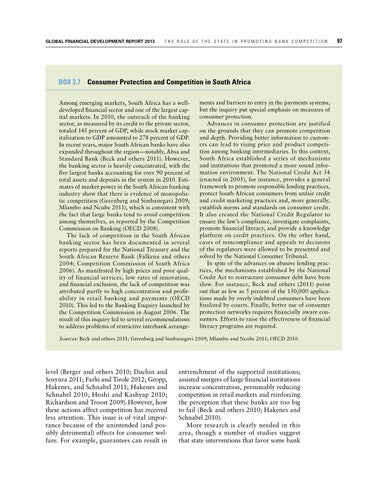GLOBAL financial DEVELOPMENT REPORT 2013
t h e r o l e o f t h e s t a t e i n p r o m o t i n g b a n k c o m p e t i t i o n 97
Box 3.7 Consumer Protection and Competition in South Africa Among emerging markets, South Africa has a welldeveloped financial sector and one of the largest capital markets. In 2010, the outreach of the banking sector, as measured by its credit to the private sector, totaled 145 percent of GDP, while stock market capitalization to GDP amounted to 278 percent of GDP. In recent years, major South African banks have also expanded throughout the region—notably, Absa and Standard Bank (Beck and others 2011). However, the banking sector is heavily concentrated, with the five largest banks accounting for over 90 percent of total assets and deposits in the system in 2010. Estimates of market power in the South African banking industry show that there is evidence of monopolistic competition (Greenberg and Simbanegavi 2009; Mlambo and Ncube 2011), which is consistent with the fact that large banks tend to avoid competition among themselves, as reported by the Competition Commission on Banking (OECD 2008). The lack of competition in the South African banking sector has been documented in several reports prepared for the National Treasury and the South African Reserve Bank (Falkena and others 2004; Competition Commission of South Africa 2006). As manifested by high prices and poor quality of financial services, low rates of innovation, and financial exclusion, the lack of competition was attributed partly to high concentration and profitability in retail banking and payments (OECD 2010). This led to the Banking Enquiry launched by the Competition Commission in August 2006. The result of this inquiry led to several recommendations to address problems of restrictive interbank arrange-
ments and barriers to entry in the payments systems, but the inquiry put special emphasis on measures of consumer protection. Advances in consumer protection are justified on the grounds that they can promote competition and depth. Providing better information to customers can lead to rising price and product competition among banking intermediaries. In this context, South Africa established a series of mechanisms and institutions that promoted a more sound information environment. The National Credit Act 34 (enacted in 2005), for instance, provides a general framework to promote responsible lending practices, protect South African consumers from unfair credit and credit marketing practices and, more generally, establish norms and standards on consumer credit. It also created the National Credit Regulator to ensure the law’s compliance, investigate complaints, promote financial literacy, and provide a knowledge platform on credit practices. On the other hand, cases of noncompliance and appeals to decisions of the regulators were allowed to be presented and solved by the National Consumer Tribunal. In spite of the advances on abusive lending practices, the mechanisms established by the National Credit Act to restructure consumer debt have been slow. For instance, Beck and others (2011) point out that as few as 5 percent of the 150,000 applications made by overly indebted consumers have been finalized by courts. Finally, better use of consumer protection networks requires financially aware consumers. Efforts to raise the effectiveness of financial literacy programs are required.
Sources: Beck and others 2011; Greenberg and Simbanegavi 2009; Mlambo and Ncube 2011; OECD 2010.
level (Berger and others 2010; Duchin and Sosyura 2011; Farhi and Tirole 2012; Gropp, Hakenes, and Schnabel 2011; Hakenes and Schnabel 2010; Hoshi and Kashyap 2010; Richardson and Troost 2009). However, how these actions affect competition has received less attention. This issue is of vital importance because of the unintended (and possibly detrimental) effects for consumer welfare. For example, guarantees can result in
entrenchment of the supported institutions; assisted mergers of large financial institutions increase concentration, presumably reducing competition in retail markets and reinforcing the perception that these banks are too big to fail (Beck and others 2010; Hakenes and Schnabel 2010). More research is clearly needed in this area, though a number of studies suggest that state interventions that favor some bank
